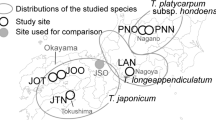Summary
Earlier studies showed that under natural conditions foreign pollen receipt is correlated with loss of seed set in populations of P. viscosum. Here, we report on experimental pollinations using foreign pollen from two co-flowering species that share pollinators with P. viscosum. Experiments were designed to ascertain whether improper pollen transfer causes reduced seed set under controlled conditions and, if so, to determine the stage at which interference occurs. In flowers pre-treated by pollination with either Mertensia or Castilleja pollen, adherence of subsequently deposited conspecific pollen grains was unaffected. However, conspecific grains had significantly lower germination and ovule fertilization success in flowers receiving foreign pollen than in controls. These results suggest that pollinator infidelity in high alpine plant communities can reduce female reproductive success of P. viscosum by inhibiting the performance of conspecific pollen grains. Negative effects of Mertensia and Castilleja pollen were comparable despite large interspecific differences in pollen grain morphology. Accordingly, susceptibility to foreign pollen interference appears to be an intrinsic property of P. viscosum that is not dependent on the unique structural properties of pollen produced by competitive species.
Similar content being viewed by others
References
Alexander MP (1969) Differential staining of aborted and nonaborted pollen. Stain Technol 44:117–122
Armbruster WS, Herzig AL (1984) Partitioning and sharing of pollinators by four sympatric species of Dalechampia (Euphorbiaceae) in Panama. Ann M Bot Gard 71:1–16
Campbell DR (1985a) Pollen and gene dispersal: the influences of competition for pollination. Evolution 39:418–431
Campbell DR (1985b) Pollinator sharing and seed set of Stellaria pubera: competition for pollination. Evology 66:544–553
Campbell DR, Motten AF (1985) The mechanism of competition between two forest herbs. Ecology 66:544–563
Davidson JF (1950) The genus Polemonium (Tournefort) L. Univ Calif Berkeley Publ Bot 23:209–282
Feinsinger P, Murray, KG, Kinsman S, Busby WH (1986) Floral neighborhood and pollination success in four hummingbird-pollinated cloud forest plant species. Ecology 67:449–464
Feinsinger P, Busby WH, Tiebout III HM (1988) Effects of indiscriminate foraging by tropical hummingbirds on pollination and plant reproductive success: experiments with two tropical treelets (Rubiacae). Oecologia (Berlin) 76:471–474
Galen C (1983) The ecology of floral scent variation in Polemonium viscosum Nutt. (Polemoniaceae). Ph.D dissertation, Univ Texas, Austin
Galen C (1985) Regulation of seed-set in Polemonium viscosum: floral scents, pollination and resources. Ecology 66:792–797
Galen C, Newport MEA (1987) Bumble bee behavior and selection on flower size in the sky pilot, Polemonium viscosum. Oecologia (Berlin) 74:20–23
Galen C, Newport MEA (1988) Pollination quality, seed set, and flower traits in Polemonium viscosum: complementary effects of variation in flower scent and size. Am J Bot 75:900–905
Galen C, Zimmer KA, Newport MEA (1987) Pollination in floral scent morphs of Polemonium viscosum: a mechanism for disruptive selection on flower size. Evolution 41:599–606
Levin DA, Anderson WW (1970) Competition for pollinators between simultaneosly flowering plant species. Am Nat 104:455–467
Macior LW (1974) Pollination ecology of the Front Range of the Colorado Rocky Mountains. Melanderia 15:1–59
Rathcke BJ (1983) Competition and facilitation among plants for pollination. In: Jones CE, Little RJ (eds) Handbook of experimental pollination biology. Van Nostrand Reinhold, NY, pp 305–329
Rathcke BJ (1988) Interactions for pollination among coflowering shrubs. Ecology 69:446–457
Sukada K, Jayachandra (1980) Pollen allelopathy — a new phenomenon. New Phytol 84:739–746
Thomson JD (1989) Germination schedules of pollen grains: implications for pollen selection. Evolution 43:220–222
Thomson JD, Andrews BJ, Plowright RC (1981) The effect of a foreign pollen on ovule development in Diervilla lonicera (Caprifoliaceae). New Phytol 90:777–783
Waser NM (1978a) Competition for hummingbird pollination and sequential flowering in two Colorado wildflowers. Ecology 59:939–944
Waser NM (1978b) Interspecific pollen transfer and competition between co-occurring plant species. Oecologia (Berlin) 55:251–257
Waser NM (1983) Competition for pollination and floral character differences among sympatric plant species: a review of evidence. In: Jones CE, Little RJ (eds) Handbook of experimental pollination biology. Van Nostrand Reinhold, NY, pp 277–293
Waser NM, Fugate ML (1986) Pollen precedence and stigma closure: a mechanism of competition for pollination between Delphinium nelsonii and Ipomopsis aggregata. Oecologia (Berlin) 70:573–577
Zar JH (1984) Biostatistical analysis. Prentice-Hall, Englewood Cliffs NJ
Author information
Authors and Affiliations
Rights and permissions
About this article
Cite this article
Galen, C., Gregory, T. Interspecific pollen transfer as a mechanism of competition: Consequences of foreign pollen contamination for seed set in the alpine wildflower, Polemonium viscosum . Oecologia 81, 120–123 (1989). https://doi.org/10.1007/BF00377020
Received:
Accepted:
Issue Date:
DOI: https://doi.org/10.1007/BF00377020




